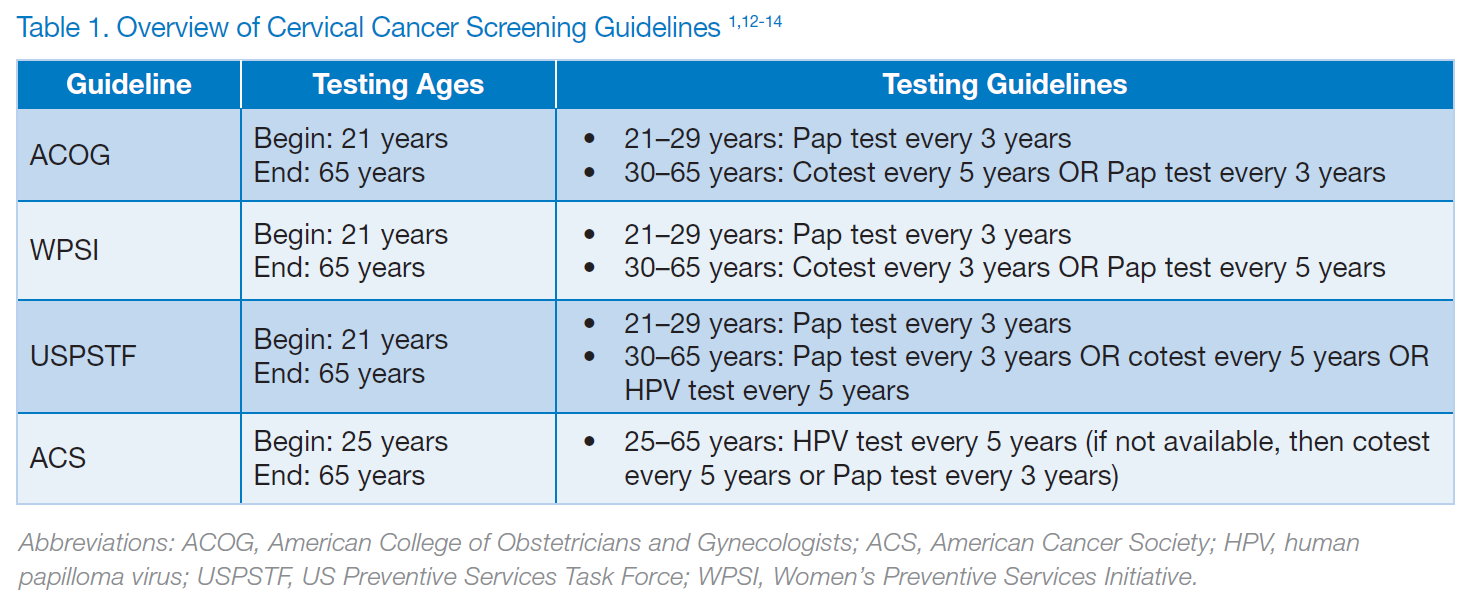Cervical cancer screening with cotesting is best for women
Sponsored Content

Partner Perspectives allows marketers to connect directly with the Contemporary OBGYN audience by enabling them to share their content. This content does not necessarily reflect the views of Contemporary OBGYN editorial staff or MJH Life Sciences.
Sponsored by: Hologic
As obstetricians/gynecologists (ob/gyns),we have seen the proven benefits of cotesting with a Pap test and human papilloma virus (HPV) test for cervical cancer screening in women. Cotesting is widely used and preferred by the majority of ob/gyns. Scientific evidence and professional society guidelines strongly reinforce the value of this screening method, which is why the newly released guidelines from the American Cancer Society (ACS) are concerning.1 The ACS departs from other current medical guidance and advocates for the eventual elimination of Pap testing and cotesting in favor of HPV-alone testing and states that initial cervical cancer screening should begin at age 25 years instead of age 21.1 These new guidelines have prompted questions and concerns from providers like myself who are on the frontlines of patient care. We know the value of the Pap test and what it adds to cervical cancer screening. Before widespread use of the Pap test, cervical cancer was the most common cause of cancer death among women in the United States.2 Today, it is estimated to be the 15th cause, with an estimated 4,290 preventable deaths per year.3,4 We have made decades of progress toward eliminating this cancer, and taking away the most successful screening tool in history as the ACS recommends would have negative repercussions for women and their health. A close examination of the ACS guidelines reveals several significant concerns that should cause ob/gyns to question this new guidance.
Concerns with the ACS guidelines
Clinical challenges with HPV-alone testing
The revised ACS guidelines recommend HPV-alone testing over cotesting as the preferred method and move the age at which HPV-alone testing is recommended down to age 25 years. Evidence supporting the long-term reduction of cervical cancer compared to the currently recommended screening options is lacking.5 Worse yet, this proposed change will lead to increased colposcopies and follow-up procedures in women age 25 to 29 years, which pose a risk of serious complications such as loss of a future pregnancy or preterm birth. Other countries that have recently changed from cytology to HPV-alone testing have reported significant increases in follow-up procedures, potentially providing a window into the future for US women. Specifically, the implementation of HPV-alone testing in Australia led to a 6-fold increase in colposcopy rates.6
These concerns are recognized by most US women’s healthcare providers, as shown in a recent survey conducted by the National Association of Nurse Practitioners in Women’s Health (NPWH) and HealthyWomen.7 The survey explored opinions from healthcare providers (ie, ob/gyns, nurse practitioners, primary care physicians) and patients about testingfor cervical cancer. Less than 1% of healthcare providers said they screen using HPV-alone testing. The survey found that when it comes to HPV-alone testing, healthcare providers fear the possibility of more missed diagnoses (62%), more recommendations for colposcopies (61%), and more positive diagnoses with no treatment options offered to patients (58%).7
Removing the Pap test from the screening process also eliminates the ancillary benefit of detecting additional infections, gynecologic malignancies, and other asymptomatic cancers that may not be diagnosed otherwise. This may not be the primary purpose of the Pap test, but it represents additional valuable information that healthcare providers would lose under the proposed guidelines of the ACS. The patient experience of sample collection remains the same whether the lab runs a Pap test and HPV test together or an HPV test alone. Patients and healthcare providers will be better served gathering more information from each visit to better inform follow-up guidance and treatment decisions.
ACS data modeling questions
Modeling of cervical cancer screening outcomes represents a major part of the rationale supporting the new ACS guidelines. A review of assumptions, inputs, and predictions to better understand the applicability and representativeness of the model raises a number of questions:
- Why does the model exclude endocervical disease when we see increasing rates of adenocarcinoma in the population and know that cotesting provides the best chance of identifying adenocarcinoma and adenocarcinoma in situ?
- Why do the model inputs for cytology performance rely predominantly on conventional cytology and data from countries outside the United States?
- How can the model predict the identification of more treatable precancer (ie, cervical intraepithelial neoplasia 2 [CIN2], CIN3) using cotesting versus HPV-alone testing, yet at the same time predict a higher incidence and death rate using cotesting?
- Why do the modeled scenarios indicate that adding Pap testing will result in higher incidence and death from cervical cancer?
Mathematical models are an important tool to support decision making on best practices, but we have to ensure that the information utilized in making predictions and the outputs generated accurately and appropriately represent what we observe in clinical practice everyday.
Overreliance on HPV vaccination rates
The ACS guidelines ignore HPV vaccination realities in the United States. Rarely do healthcare providers have access to complete vaccine records, and it should not be assumed that US women successfully completed the recommended HPV vaccination regimen. The CDC found that less than half of adolescents in this country have completed the HPV vaccination series.8 In the National Immunization Survey-Teen (2017–2018; N = 82,297), 37.1% of participants were unvaccinated and 10.8% had received only one vaccine dose.9 We also need to consider that many women currently at risk for cervical cancer did not receive the HPV vaccination regimen given their age when the vaccine was released in 2006. Although it is vitally important to advocate for greater HPV vaccination compliance, we should be careful not to alter guidelines and current practice based on overly optimistic assumptions.
Call for real-world data inclusion
The ACS guidelines primarily rely on data generated in Europe from randomized clinical trials and the experience of the Kaiser Permanente Northern California (KPNC) regional integrated healthcare system.1 Data from these studies represent best-case scenarios with respect to test utilization and adherence to follow-up and therefore do not represent the experiences of most women across the United States. Evaluating evidence from more representative settings in this country may be able to better inform future cervical cancer screening guidelines. In fact, data documenting the contribution of the Pap test and HPV test in the detection of cervical disease in routine cervical cancer screening from the University of Pittsburgh Medical Center and Quest Diagnostics have been published and highlight marked differences in outcomes, especially compared to the data reported from the KPNC system.10,11 These data show a much larger contribution of the Pap test to cotesting in identifying precancer and cancer than previously reported by KPNC.
Real-world evidence is critical to our understanding and direction forward because we lack a nationwide, organized cervical cancer screening program. The aforementioned data sets as well as additional data need to be more carefully evaluated and incorporated into the decision-making process by organizations and societies issuing cervical cancer screening guidelines to ensure that they are representative of all women in the current US healthcare setting.

Diverging from guidelines and preferences
Increasing the rate of cervical cancer screening among our patients must start with clear, consistent guidelines. Current guidelines from the American College of Obstetricians and Gynecologists (ACOG), Women’s Preventive Services Initiative (WPSI), and the US Preventive Services Task Force (USPSTF) are aligned on the starting age for screening and the continued role of Pap testing alone or in combination with HPV testing depending on a woman’s age (Table).1,12–14 The revised ACS guidelines diverge significantly and stand alone as an outlier among these institutions.1 It is important to note on the issuance of the ACS guidelines that ACOG reinforced their position on cotesting, as did other groups such as the American Society of Clinical Pathology. In addition to support for cotesting in guidelines, healthcare providers and women believe in the unequivocal value of cotesting. The NPWH and HealthyWomen survey showed that over the past 5 years, there has been an increase in the number of healthcare providers and women who consider using the Pap and HPV tests together as being important to overall health.7 Additionally, 95% of healthcare providers and 90% of women consider the Pap test valuable in screening for cervical cancer.7
The survey showed that 89% of healthcare providers believe cotesting is essential for women’s health.7 Unfortunately, even with this broad support, screening rates remain suboptimal and the percentage of screening-eligible women who are up to date with their cervical cancer screening has never reached the 93% threshold set by the Healthy People 2020 initiative. In fact, shockingly, screening rates have been in decline since the early 2000s. Currently, less than 80% of women are up to date with their cervical cancer screenings, with one study putting that percentage at an alarming low total of approximately 65%.8,9 The NPWH and HealthyWomen survey findings indicate that rather than removing support for cotesting, now is the time to reinforce support for the screening method that is most trusted to help avoid confusion and reduce the decline in screening rates.
Implications for the patient–provider relationship
By suggesting that women younger than age 25 years do not need cervical cancer screening, I believe the ACS guidelines will open the door to several other negative outcomes. First, any decline in ob/gyn visits from these younger women may cause healthcare providers to lose other important touchpoints with their patients, such as opportunities to screen for sexually transmitted infections (STIs). Testing and education about risk reduction for STIs are part of the care of this young age group and have significant implications for future reproductive health.
Most importantly, while the incidence of cervical cancer in women younger than age 25 years is low, I do not know any ob/gyns willing to accept missing the diagnosis in one of these women and the harm it would cause. We should maintain management of these cases rather than giving up on detecting them altogether.
The potential to miss cases and other problematic infections in younger women further demonstrates the unnecessary risks associated with transitioning to HPV- alone testing. We cannot ignore the larger challenges to the patient–provider relationship that would result from the utilization of the ACS guidelines experiment.
Conclusion
Screening guidelines for a condition as serious and preventable as cervical cancer should be developed based on the most rigorous assessment of current technologies applied to a large, heterogeneous, geographically distributed, and socioeconomically diverse population as possible, because such factors represent the conditions under which most care is provided throughout this country.10 It is inadvisable to advocate for a screening strategy for which very little observational data exist in the United States.
The clinical evidence shows that cotesting is the most sensitive and safe approach to cervical cancer screening. With this knowledge, the majority of providers are utilizing this approach to care for their patients today. Future efforts to further reduce cervical cancer incidence and mortality should focus on expanding screening and care to those women who currently do not participate for one reason or another.
Regularly assessing guidelines is important to ensure that patients are receiving the best healthcare available at the time. Changes and attempts to simplify the screening process, however, do not necessarily lead to better patient care or outcomes. None of the evidence I have reviewed suggests that moving to HPV-alone testing every 5 years starting at age 25 years will improve the health of women or lead to an increase in the percentage of women being up to date with their screenings and well-woman visits. In fact, I believe it will have the opposite effect.
Healthcare providers should continue to recommend Pap tests every 3 years starting at age 21 years and cotesting every 3 to 5 years starting at age 30—an approach that continues to be in the best interest, safety, and health of women in the United States.

Dr. Navkaran Singh is in a private obstetrics/gynecology practice in Las Vegas, Nevada. He was previously in Cincinnati, Ohio, where he developed his extensive clinical skills over a 24-year period in private practice and as Residency Director at The Christ Hospital. He received his undergraduate degree in Bio-Medical Engineering at Northwestern University and his medical degree at the Ohio State University College of Medicine. He completed his residency in obstetrics and gynecology at the University of Cincinnati Medical Center in 1993. While in Cincinnati, he cofounded a 50-provider ob/gyn group practice and, as the chair of its quality committee, forged guidelines and developed research protocols regarding PCR technologies useful in the evaluation of vaginal infections.
References
1. Fontham ETH, Wolf AMD, Church TR, et al. Cervical cancer screening for individuals at average risk: 2020 guideline update from the American Cancer Society. CA Cancer J Clin. 2020 July 30. Online ahead of print.
2. Centers for Disease Control and Prevention. Cervical cancer statistics. June 8, 2020. Available at https://www.cdc.gov/cancer/cervical/statistics/index.htm. Accessed September 27, 2020.
3. National Institutes of Health. National Cancer Institute. Cancer stat facts: Cervical cancer. Available at https://seer.cancer.gov/statfacts/html/cervix.html. Accessed September 27, 2020.
4. American Cancer Society. Cancer facts and figures 2020. Available at https://www.cancer.org/content/dam/cancer-org/research/cancer-facts-and-statistics/annual-cancer-facts-and-figures/2020/cancer-facts-and-figures-2020.pdf. Accessed September 27, 2020.
5. Ronco G, Dillner J, Elfström KM, et al; International HPV screening working group. Efficacy of HPV-based screening for prevention of invasive cervical cancer: follow-up of four European randomised controlled trials. Lancet. 2014;383(9916):524-532.
6. Sii S, Trivedi A, Wang WC. Analysis of the Peninsula Health colposcopy service data of one year since transitioning to the new cervical screening program. Obstet Gynecol Res. 2019;2(4):88-99.
7. Albright DM, Rawlins S, Wu JS. Cervical cancer today: survey of screening behaviors and attitudes. Women’s Healthcare. 2020;8(3):41-46.
8. Centers for Disease Control and Prevention. Human papillomavirus (HPV). Understanding HPV coverage. Available at https://www.cdc.gov/hpv/partners/outreach-hcp/hpv-coverage.html. Accessed September 27, 2020.
9. Sonawane K, Zhu Y, Montealegre JR, et al. Parental intent to initiate and complete the human papillomavirus vaccine series in the USA: a nationwide, cross-sectional survey. Lancet Public Health. 2020;5(9):e484-e492.
10. Kaufman HW, Alagia DP, Chen Z, et al. Contributions of liquid-based (Papanicolaou) cytology and human papillomavirus testing in cotesting for detection of cervical cancer and precancer in the United States. Am J Clin Pathol. 2020;154(4):510-516.
11. Austin RM, Onisko A, Zhao C. Enhanced detection of cervical cancer and precancer through use of imaged liquid-based cytology in routine cytology and HPV cotesting. Am J Clin Pathol. 2018;150(5):385-392.
12. American College of Obstetricians and Gynecologists. Cervical cancer screening (update). Available at https://www.acog.org/clinical/clinical-guidance/practice-advisory/articles/2018/08/cervical-cancerscreening-update. Accessed September 27, 2020.
13. US Preventive Services Task Force; Curry SJ, Krist AH, Owens DK, et al. Screening for cervical cancer: US Preventive Services Task Force Recommendation Statement. JAMA. 2018;320(7):674-686.
14. Women’s Preventive Services Initiative. Screening for cervical cancer. Available at: https://www.womenspreventivehealth.org/recommendations/screening-for-cervical-cancer/. Accessed September 27, 2020.

Content of this article was sponsored by Hologic. Copyright 2020 and published by MJH Life Sciences. No portion of this program may be reproduced or transmitted in any form, by any means, without the prior written permission of MJH Life Sciences. The views and opinions expressed in this material do not necessarily reflect the views and opinions of MJH Life Sciences, or Contemporary OB/GYN.
